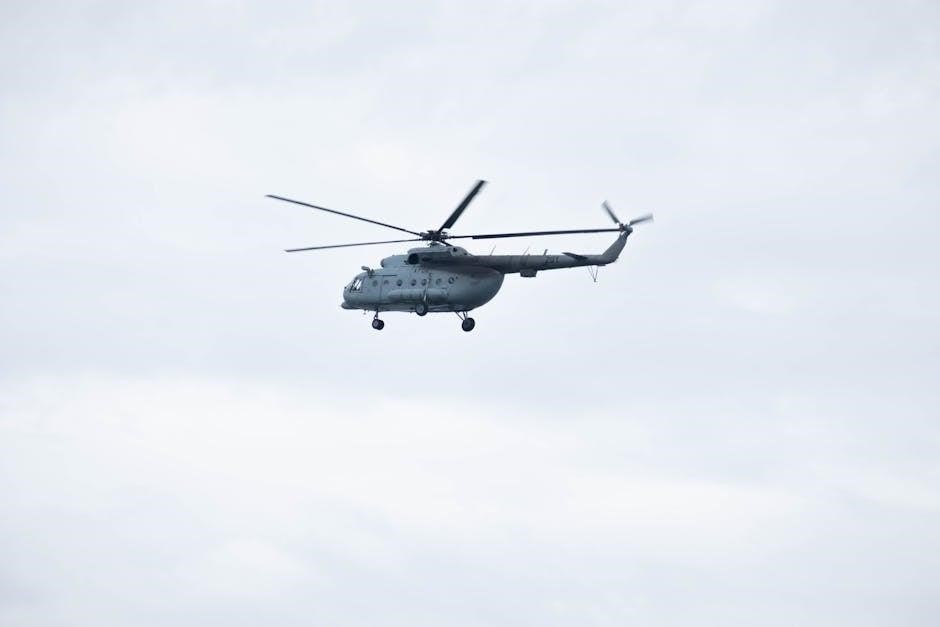mil std 810 pdf
MIL-STD-810 is a U.S. military standard for environmental testing, published by the Department of Defense, ensuring equipment durability against extreme conditions like temperature, vibration, and humidity.
Overview of the Standard
MIL-STD-810 is a U.S. Department of Defense test method standard for environmental engineering and laboratory testing. It provides guidelines to ensure equipment withstands various environmental stresses like temperature, humidity, vibration, and shock. The standard helps tailor designs and tests to specific conditions, ensuring reliability and performance. It applies to military and commercial applications, offering a flexible framework for durability testing across industries. MIL-STD-810 does not dictate design but offers methods to simulate real-world conditions, making it a critical tool for ruggedized equipment development.
Importance of Environmental Testing
Environmental testing under MIL-STD-810 ensures equipment reliability and performance in harsh conditions. It identifies vulnerabilities, ensuring devices function in extreme temperatures, humidity, vibrations, and shocks. This testing is crucial for military equipment, where failure can have critical consequences. It also benefits commercial and industrial products, enhancing durability and user confidence. By simulating real-world stresses, MIL-STD-810 testing helps manufacturers design resilient products, reducing maintenance and extending lifespan. This standard is vital for ensuring operational readiness and safety in diverse environments.

Purpose and Scope of MIL-STD-810
MIL-STD-810 is a test method standard for environmental engineering, aiding in tailoring designs and tests to specific conditions, ensuring realistic and robust product development.
Environmental Engineering Considerations
MIL-STD-810 focuses on environmental engineering to ensure equipment withstands real-world conditions. It provides guidelines for tailoring designs and tests to specific environmental stresses, such as temperature, humidity, and vibration. The standard emphasizes understanding the service life conditions of materiel to develop realistic test methods. It does not impose strict design or test specifications but offers a framework for environmental tailoring. This approach ensures products are resilient, reliable, and perform effectively under various operational scenarios, making it a critical tool for both military and commercial applications.
Lab Testing Objectives

The primary objective of MIL-STD-810 lab testing is to evaluate equipment performance under extreme environmental conditions. Tests replicate real-world stresses like temperature, humidity, and vibration to ensure reliability. By simulating these conditions, manufacturers can identify design weaknesses and validate durability. The tests aim to confirm that products meet specified requirements and can operate effectively in harsh environments. This rigorous process ensures equipment resilience, reducing risks of failure during deployment. It also helps in optimizing designs for diverse operational scenarios, aligning with the standard’s focus on environmental tailoring and performance-based testing.

Key Test Methods in MIL-STD-810
MIL-STD-810 includes tests for temperature, humidity, vibration, and altitude to ensure equipment withstands harsh environments. These methods validate durability and performance under extreme conditions.
Temperature and Humidity Testing
MIL-STD-810 includes rigorous temperature and humidity tests to evaluate equipment performance under extreme conditions. These tests expose devices to high and low temperatures, as well as humidity, to ensure reliability. They simulate real-world environmental stresses, such as desert heat or tropical moisture, to identify potential failures. The standard provides detailed procedures for temperature cycling, steady-state temperatures, and humidity testing. This ensures equipment can operate effectively in various climates and withstand long-term exposure to environmental extremes.
- Tests cover temperature ranges from -40°C to +120°C.
- Humidity levels simulate tropical and marine environments.
- These tests ensure equipment durability and operational consistency.

Vibration and Shock Testing
MIL-STD-810 includes vibration and shock tests to evaluate equipment resilience against mechanical stresses. These tests simulate real-world conditions like transportation, combat, and sudden impacts. Vibration testing involves exposing devices to controlled sine and random vibrations to assess structural integrity. Shock testing ensures equipment can withstand sudden, high-force impacts without damage. Both tests are critical for ensuring reliability in demanding environments. The standard provides detailed protocols for test durations, frequencies, and intensities, ensuring equipment meets rigorous military standards for durability and operational readiness.
- Vibration tests cover sine and random vibration profiles.
- Shock tests simulate drops, crashes, and explosive forces.
- These evaluations ensure equipment survives harsh operational conditions.
Altitude and Atmospheric Testing
MIL-STD-810 includes altitude and atmospheric testing to assess equipment performance under low-pressure, high-altitude conditions. These tests simulate environments with reduced oxygen levels and temperature variations. Devices are exposed to controlled vacuum chambers or hypobaric chambers to evaluate their ability to function in thin air. The standard ensures equipment can withstand rapid pressure changes, humidity fluctuations, and extreme temperature shifts at high altitudes. This testing is critical for systems deployed in aircraft, space, or high-altitude terrestrial environments, ensuring reliability in challenging atmospheric conditions.
- Tests simulate high-altitude environments with reduced air pressure.
- Equipment is evaluated for functionality in low-oxygen conditions.
- Atmospheric testing ensures resilience to temperature and humidity variations.

Revisions of MIL-STD-810
MIL-STD-810 has undergone several revisions, with MIL-STD-810F introducing environmental tailoring, MIL-STD-810G updating test methods, and MIL-STD-810H adding detailed procedures for modern equipment testing.
MIL-STD-810F
MIL-STD-810F introduced the concept of environmental tailoring, allowing materiel design and testing to be customized to specific environmental conditions encountered during service. This revision emphasized realistic testing, ensuring equipment could withstand harsh conditions without over-specifying design requirements. It provided detailed guidelines for tailoring test methods to align with actual operational environments, making it a significant update for military and commercial applications. This approach ensured cost-effectiveness while maintaining reliability and performance in diverse settings. MIL-STD-810F remains a foundational document for environmental testing standards.
MIL-STD-810G
MIL-STD-810G, released in 2008, expanded the scope of environmental testing, introducing new test methods and refining existing ones. It emphasized environmental engineering considerations and lab testing for military equipment. Key updates included the addition of solar radiation testing and enhanced guidelines for humidity, vibration, and temperature testing. The revision also provided clearer procedures for tailoring tests to specific environmental conditions, ensuring equipment reliability in real-world scenarios. MIL-STD-810G became a critical reference for both military and commercial applications, offering detailed methodologies to validate durability and performance under harsh conditions.
MIL-STD-810H
MIL-STD-810H, released in 2019, is the latest revision of the standard, incorporating emerging trends and technologies. It introduces updated test methods for extreme temperatures, humidity, and vibration, ensuring equipment reliability in harsh environments. The revision emphasizes cybersecurity considerations and IoT compatibility, aligning with modern technological advancements. MIL-STD-810H also expands testing for renewable energy systems and addresses environmental challenges like solar radiation and icing conditions. This version builds on the legacy of previous revisions while adapting to the evolving needs of military and commercial applications, ensuring robust durability and performance in diverse scenarios.

Application Beyond Military Use
MIL-STD-810’s environmental testing protocols are widely adopted beyond military use, benefiting industries like aerospace, automotive, and consumer electronics. Its standards ensure product durability and reliability in harsh conditions.
Commercial Applications
MIL-STD-810’s rigorous environmental testing protocols are increasingly adopted by commercial industries. Companies in aerospace, automotive, and consumer electronics use these standards to ensure product durability. Rugged devices, such as smartphones and laptops, often adhere to MIL-STD-810, demonstrating resistance to extreme temperatures, shocks, and vibrations. This certification enhances reliability, making it a trusted benchmark for manufacturers aiming to meet consumer demands for robust, long-lasting products in challenging environments.
Industrial and Consumer Products
MIL-STD-810’s environmental testing standards are widely applied to industrial and consumer products, ensuring durability in harsh conditions. Industrial equipment, such as machinery and tools, benefits from these tests to withstand extreme temperatures, vibrations, and shocks. Consumer electronics, like smartphones and laptops, also leverage MIL-STD-810 to demonstrate resilience. This certification assures users of product reliability, making it a valuable benchmark for manufacturers. By adhering to these standards, companies enhance the robustness of their products, catering to both industrial and consumer demands for long-lasting, high-performance devices.

Preparation and Compliance
Preparation involves tailoring design and test criteria to specific environmental conditions, ensuring compliance with MIL-STD-810’s rigorous standards for durability and performance in harsh conditions.
Design Considerations
Design considerations under MIL-STD-810 involve tailoring equipment to withstand specific environmental stresses, such as temperature, vibration, and humidity. Engineers must align designs with real-world operational conditions, ensuring reliability. Material selection and structural integrity are critical to meeting the standard’s durability requirements. The process includes analyzing environmental factors and incorporating safeguards to mitigate potential failures. This approach ensures equipment performs effectively in harsh conditions, aligning with the standard’s goal of realistic and reliable designs.

Testing Procedures
Testing procedures under MIL-STD-810 involve rigorous environmental assessments to validate equipment durability. These include simulations of extreme conditions like temperature, humidity, and vibration. Each test method is tailored to specific environmental stresses, ensuring realistic evaluation. The standard outlines detailed steps for conducting laboratory tests, such as temperature shock and altitude testing. Results are analyzed to confirm equipment performance under harsh conditions. This systematic approach ensures compliance and reliability, making MIL-STD-810 a cornerstone for military and industrial equipment validation.
Real-World Examples
MIL-STD-810 is widely applied in military gear, rugged electronics, and industrial equipment, ensuring reliability in extreme conditions like high temperatures, humidity, and vibrations, proving its effectiveness.
Case Studies
Several real-world applications demonstrate MIL-STD-810’s effectiveness. For instance, military communication devices tested under MIL-STD-810G withstand extreme temperatures and vibrations, ensuring reliability in combat zones. Consumer electronics, like rugged smartphones, are validated against drops, humidity, and thermal shocks, meeting MIL-STD-810H criteria. Industrial sensors exposed to harsh environments also benefit from these tests. These case studies highlight how the standard ensures durability and performance across diverse industries, proving its versatility and value in real-world scenarios. The results underscore the importance of adhering to MIL-STD-810 guidelines for reliable operation in challenging conditions.
Success Stories
MIL-STD-810 compliance has enabled numerous products to excel in harsh environments. For example, aerospace equipment meeting MIL-STD-810H withstands extreme temperatures and vibrations, ensuring reliable performance. Industrial machinery, such as mining equipment, has successfully endured rigorous vibration and shock testing. Consumer electronics, like tablets designed for outdoor use, have passed MIL-STD-810 tests for drops, humidity, and thermal variations. These success stories demonstrate how adherence to the standard enhances product reliability and longevity, meeting the demands of both military and civilian applications. The widespread adoption of MIL-STD-810 underscores its effectiveness in ensuring durability across industries.
Future of MIL-STD-810
MIL-STD-810 continues to evolve, incorporating emerging technologies and environmental considerations. Future revisions aim to address new challenges, ensuring equipment reliability in increasingly complex operational environments.
Emerging Trends
MIL-STD-810 is evolving to address modern challenges, integrating new technologies and environmental considerations. Emerging trends include enhanced testing for cybersecurity threats and connectivity in rugged devices. The standard now incorporates advanced methodologies for evaluating equipment resilience against electromagnetic interference and extreme weather conditions. There is also a growing focus on sustainability and energy efficiency in military equipment. These updates ensure that MIL-STD-810 remains relevant, supporting the development of robust, reliable systems for future military and commercial applications.
Upcoming Revisions
Future updates to MIL-STD-810 aim to address emerging environmental challenges and technological advancements. Revisions will likely focus on new stressors such as extreme weather patterns, cybersecurity threats, and advanced material durability. The standard may also incorporate updated testing methodologies for interconnected systems and IoT devices. Sustainability and energy efficiency are expected to be key areas of focus. These revisions ensure the standard remains aligned with modern military and commercial needs, providing robust guidelines for equipment resilience in evolving operational environments.
